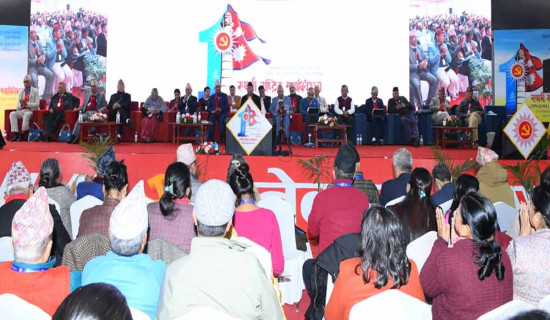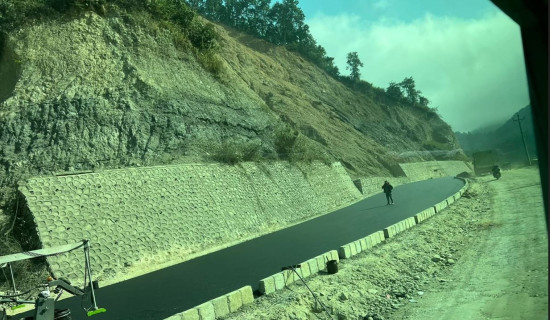- Monday, 15 December 2025
Give Propulsion To Aviation Sector
Nepal is a cultural and religious country and Akash Bhairab and Shweta Bhairab are remembered as the Gods that guide the flights. However, as the private sector in the country is increasing, recent fatalities, particularly the cases of mountain flights and the accident in Pokhara this year, have highlighted the need to give due consideration to flight safety. As aeroplanes are increasing, we tend to forget that frequent flights have adverse impacts on climate change. The lives of pilots and the crews have been romanticised, but their risks have often been undermined.
In their book, ‘A Man with A Mission’ writers Maheshwor Bhakta Shreshtha and Jaya Rajya Laxmi Shah try to capture the hardships and romanticisation of the history of Nepal’s civil aviation sector and the life, love and duty of captain Bobby Shah. The book covers a sequential recording of facts since the days of the creators of aeroplane, the Wright Brothers, to the space travel of the billionaire Richard Bronson and the establishment of Nepal’s national flag carrier the Royal Nepal Airlines Corporation (RNAC) in July of 1958. Coincidentally, this year the Thai Airlines commenced its journey in Thailand. Often there is comparison as to why Thai Airways since then has become a profit-making entity whereas the Nepal Airlines Corporation (NAC) renamed later, has lagged far behind.
NAC’s safe flights
However, the Nepali flag carrier has been providing regular schedule flights within the country and internationally for the past 65 years and has a record of its jet flights remaining absolutely safe for the past five decades since 1972. April 1949 heralded the beginning of NAC in Nepal. It was soon followed by regular flights of Dakota DC-3 aircraft from Calcutta and Patna to Kathmandu and within Nepal by private airlines like Himalayan Aviation, Jam Air and Kalinga Airways in early 1950, Indian National Airlines in 1951 and Indian Airlines Associates from 1953. The Nepal government then decided to establish its own national airline and joined with an Indian entrepreneur to operate Royal Nepal Airlines through an enactment of Corporation Act BS 2013.
After some 15 months of the joint venture, the government wanted to expand the aerial services to as many places as possible in this roadless country beyond the initial four cities in the Terai, namely Simara, Biratnagar, Pokhara and Bhairawa. The government later acquired full ownership and made it government-owned state airline. RNAC had a monopoly over the skies of Nepal till 1992. In the beginning of 1960s, the thrust of the airline was to acquire more aircraft, Dakota DC- 3s, Pilatus Porters PC-6, AN-2 Fung Shu, MI-4 Russian Helicopters, on purchase or grant; train many flying pilots and expand services to as many new destinations within the country as there were no road links for social and administrative integration of different parts of Nepal.
Three more DC-3 aircraft were received in 1960 under USAID and eight more DC-3s were acquired from Pakistan, KLM and Aerlingus, Ireland during 1961 to 1964. The airline received two Pilatus Porter PC-6 in 1961 under Swiss Aid, two Chinese AN-2 FungShu (Harvester) in 1963 under Chinese Aid, and two MI-4 helicopters in 1964 under Russian Aid for expansion of air services within the country. With the additional aircraft in the fleet, Royal Nepal Airlines did expand its services to Indian cities of Patna, Calcutta and Delhi and three new domestic routes Janakpur, Rajbiraj, and Gorkha in 1960. The airlines also opened services to Bharatpur, Dang and Nepalgunj in western Nepal in 1961 and Bhadrapur and Dhangadi in 1963-64. Flights to Dhaka started in 1963. Service to Surkhet and Meghauli began in 1966.
From January 1966, a new Turbo-jet age started with the acquisition of a modern Fokker Friendship F-27 aircraft with pressurised cabin. The Fokker flights modernised the services to India and the then Pakistan. The popular touristic Mountain Sightseeing flight commenced from December 1967. The Fokker aircraft was replaced by British Hawker Siddley HS-748 (Avro) from January 1970. The airlines introduced the modern Boeing 727 jet service to India, East Pakistan and Thailand from September 1972, thus successfully progressing from piston-engine Dakota age to modern Jet and Short Take Off and Landing (STOL) technology phase. The expertise of Air France and Air Alps was instrumental in the successful jet and STOL operations respectively. RNA thus became a competitive regional carrier in line with Thai Airways International, Air India and PIA. History was made by NAC, but it has not been able to be a profit-making corporation on a par with the other airlines mentioned above.
Bobby Shah’s resilience
Bobby Shah started his career with the RNAC as a co-pilot and moved on to become the managing director. This book gives vivid examples of how he flew every aircraft mentioned above, and worked hard to create a set of expert human resources. He was also the youngest Captain in Asia at the age of 24. The resilience of Bobby Shah and his commitment to his work and life can be understood by what he said to the team in the control room on 24th November 1978: “I look forward to sharing a beer with you guys after this flight is over.”
This was a historical moment when he managed his team inside the plane he was flying and assured those in the control room without giving a hint of the stress he was going through when he realised that there was a technical problem with his aircraft and he had lives to save. He, however, managed to land the plane safely despite all the odds. Before he died at the age of 49 due to cancer, Shah had completed living a life of a romantic pilot, and become part of the history of Nepal’s civil aviation. Now it is the duty of the private sector and Nepal government to keep our skies safe with blessings from all the gods who reside above us.
(Namrata Sharma is a journalist and women rights advocate. namrata1964@yahoo.com @NamrataSharmaP)
















